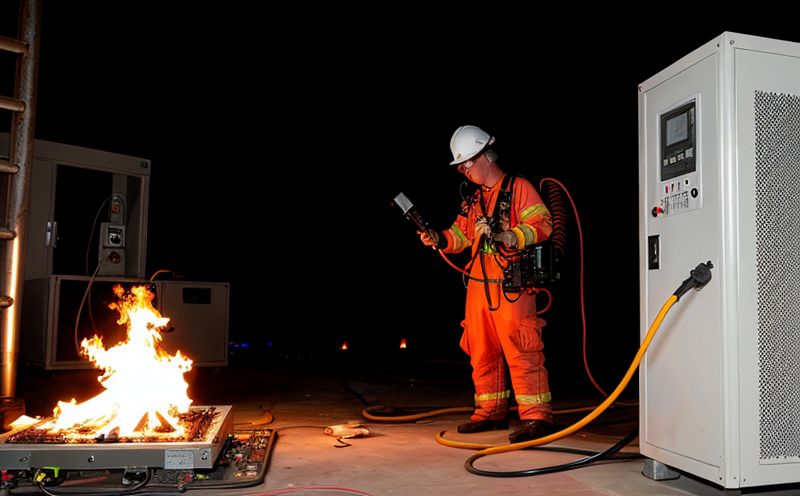Fire Resistance Testing for Surge Protectors
The fire resistance testing of surge protectors is a critical component in ensuring the safety and reliability of electrical installations, particularly in high-risk environments. Surge protectors are designed to limit the effects of overvoltage by absorbing and dissipating excess energy. However, their performance under extreme conditions is crucial for preventing fires and safeguarding personnel and property.
Fire resistance testing evaluates how a surge protector behaves when exposed to fire or heat that could be generated during an electrical fault. This test demonstrates the component's ability to withstand such hazardous environments without contributing further to the risk of fire spread. The testing process involves subjecting the surge protector to controlled fire conditions and monitoring its performance.
The methodology for this testing is standardized by international standards such as IEC 62305-1, which specifies the requirements for surge protective devices (SPDs). These standards ensure that the test procedures are consistent across different laboratories. The testing protocol typically includes steps like specimen preparation, placement in a fire chamber, application of heat or flame, and observation of performance.
Specimen preparation is critical to ensuring accurate results. Surge protectors must be mounted on appropriate supports and connected according to the standard's specifications. This ensures that any observed behavior during testing can be attributed directly to the surge protector itself rather than external factors.
The fire chamber used for this testing simulates real-world conditions as closely as possible, using controlled temperatures and durations that mimic potential fault scenarios. The test apparatus includes various sensors to monitor key parameters such as temperature rise, current flow, and flame spread rate. These measurements are essential in determining the surge protector's performance under extreme conditions.
The acceptance criteria for fire resistance testing specify that a qualified surge protector should maintain its functionality without failure or significant degradation. It must also prevent the propagation of flames to adjacent materials within specified time limits. Compliance with these standards ensures that surge protectors meet rigorous safety requirements, thereby enhancing overall electrical system reliability in challenging environments.
In conclusion, fire resistance testing for surge protectors is an essential procedure that guarantees the safe operation and longevity of these devices. By adhering to international standards like IEC 62305-1, laboratories can provide accurate and reliable test results, ensuring compliance with regulatory requirements and fostering trust in the products' performance.
Applied Standards
| Standard | Description |
|---|---|
| IEC 61554-8 | This standard specifies the methods for determining the effectiveness of SPDs in limiting surges. |
| IEC 62305-1 | It provides requirements and test procedures for surge protective devices (SPDs). |
| ASTM E1487 | This standard covers the testing of electrical equipment for fire performance. |
| NFPA 70 | American National Fire Protection Association's standard for the installation of wiring and equipment. |
| UL 1449 | Underwriters Laboratories' standard for surge protective devices. |
| CISPR 25 | This standard sets limits on conducted and radiated electromagnetic interference in radio receivers. |
Environmental and Sustainability Contributions
The implementation of fire resistance testing for surge protectors not only enhances electrical safety but also contributes positively to environmental sustainability. By ensuring that surge protectors can withstand extreme conditions without compromising performance, these tests reduce the likelihood of fires in electrical installations. This minimizes potential damage to property, disruption of services, and most importantly, loss of life.
Furthermore, compliance with international standards helps manufacturers produce reliable products that contribute to safer buildings and infrastructure worldwide. As global awareness about sustainability grows, integrating fire-resistant surge protectors into the design of modern electrical systems aligns with broader environmental goals. The use of such components can help reduce waste associated with frequent replacement due to failures under harsh conditions.
The testing process itself also promotes sustainable practices within laboratories by adhering strictly to prescribed procedures and using energy-efficient equipment. This ensures that resources are used optimally, reducing the overall carbon footprint of the testing facility while maintaining high-quality results.
In summary, fire resistance testing for surge protectors plays a vital role in promoting both immediate safety measures and long-term environmental sustainability initiatives across various sectors.
Competitive Advantage and Market Impact
The successful completion of fire resistance testing provides significant competitive advantages for manufacturers and distributors of surge protectors. By demonstrating compliance with international standards, companies can ensure their products meet the highest safety requirements, which is increasingly important in today's regulatory landscape. This compliance fosters trust among consumers and stakeholders, enhancing brand reputation and customer loyalty.
From a market perspective, fire resistance testing helps differentiate products based on their robustness and reliability under extreme conditions. In competitive markets where price points may be similar, these attributes can become differentiators that set one product apart from others. Companies that invest in thorough testing not only improve their own offerings but also contribute to overall industry standards.
The growing emphasis on safety and sustainability is driving demand for reliable surge protectors with fire-resistant properties. Manufacturers who prioritize such testing are likely to see increased market share as they cater to increasingly safety-conscious buyers. Additionally, compliance with rigorous testing protocols can open doors to new markets or segments that require stringent safety measures.
Moreover, the results of fire resistance tests can be used in marketing and sales strategies effectively. Clear communication about a product’s ability to withstand extreme conditions reassures potential customers and builds confidence in purchasing decisions. This transparency helps create a positive image for both individual products and entire brands within their respective industries.
In summary, fire resistance testing offers substantial competitive benefits by enhancing safety performance, reinforcing brand reputation, expanding market reach, and providing valuable marketing tools to companies operating in this sector.





